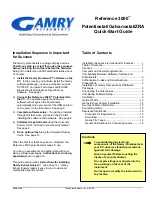
App-22
IM AQ6376-01EN
Algorithm for Analysis
mask
area
llevel
Fitting Line
noise
area
wavelength
Data range for use in the fitting calculation
Measured noise level
1. Apply channel detection to measured waveform data using the following procedure:
• Find all maximum points and minimum points to obtain mode peaks where peak/
bottom differences between maximum points and minimum points on both sides
are equal to or greater than MODE DIFF.
• Of the obtained mode peaks, choose only the ones whose level difference
compared to the highest peak is equal to or greater than THRESH. Note, however,
that mode peaks with a level difference equal to or less than DISPLAY MASK
shall be excluded. The number of mode peaks chosen in this manner shall be the
Number of Channels “N.”
2. Obtain the wavelength
λ
’i of each mode peak.
3. Determine the center wavelengths λi of each mode peak, which are 2 points down
A[dB] to the left and right from mode peak λ'I (where A[dB] is 3 dB or the MODE DIFF
setting, whichever is smaller).
4. Determine the signal level LSi of each mode according to the parameter SIGNAL
POWER setting.
• For "PEAK"
LSi = Level LPi of each mode peak
• For "INTEGRAL"
LSi = The integral of the power value in the range of the center wavelength ±Δ f [GHz]
of each mode
(Δ f : parameter INTEGRAL RANGE setting value)
5. Follow the setting of the parameter NOISE ALGO to determine the noise area and
mask area for performing the NOISE fitting.
(If the mask area is set outside the noise area when the channel wavelength
λ
i is the
center, the mask area and the noise area will become the same value.)
6. Obtain the measurement resolution RBi of each channel from the values stored in the
AQ6376.
7. According to the setting of the parameter FITTING ALGO, generate fitting waveforms
from the noise area and mask area determined in 5 and obtain the level at the center
wavelength
λ
i as the noise level Lni.
8. Using the signal level LSi and noise level LNi obtained in 4 and 7, determine the level
Li of each channel using the following equation.
Li = LSi(linear) ? LNi(linear)
Appendix 4 Detailed Explanations of WDM Analysis Function
















































